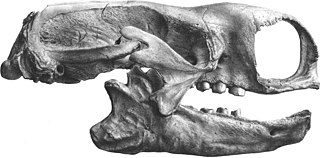
Mylodon is a genus of extinct ground sloth belonging to the family Mylodontidae, known from the region of Patagonia in Chile and Argentina in southern South America. With a total length of 3 to 4 m, it is one of the best-known and largest representatives of the group. The oldest finds probably date to the Lower Pleistocene; however, most of the fossil remains date from the Upper Pleistocene period. One of the most important sites of this phase is the Cueva del Milodón in southern Chile. Shortly after, about 10,200 BP, Mylodon became extinct. At this point in time, it coexisted with the first human colonists in America. However, there is little evidence that it was hunted by humans.
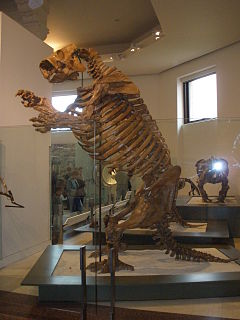
Lestodon is an extinct genus of megafaunal ground sloth from South America during the Pliocene to Pleistocene periods. Its fossil remains have been found in Argentina, Paraguay, Uruguay, Venezuela, Bolivia, and Brazil. Measuring approximately 4.6 metres (15 ft) from snout to tail tip, it is estimated to have weighed 2,590 kilograms. It was a herbivore and primarily fed on the grasses on the South American plains and is thought to perhaps have used its semi-bipedal stance to obtain foliage from trees. Lestodon is placed as member of the Mylodontidae as indicated by the lobed form of the last tooth in the dentition.

Catonyx is an extinct genus of ground sloth of the family Scelidotheriidae, endemic to South America during the Pliocene and Pleistocene epochs. It lived from 2.5 Ma to about 10,000 years ago, existing for approximately 2.49 million years. The most recent date obtained is about 9600 B.P.

Mylodontinae is a subfamily of the Mylodontidae, an extinct family of ground sloths that lived from the Middle Miocene to the Early Holocene epochs.
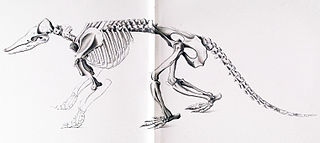
Stegotherium is an extinct genus of long-nosed armadillo, belonging to the Dasypodidae family alongside the nine-banded armadillo. It is currently the only genus recognized as a member of the tribe Stegotheriini. It lived during the Early Miocene of Patagonia and was found in Colhuehuapian rocks from the Sarmiento Formation, Santacrucian rocks from the Santa Cruz Formation, and potentially also in Colloncuran rocks from the Middle Miocene Collón Curá Formation. Its strange, almost toothless and elongated skull indicates a specialization for myrmecophagy, the eating of ants, unique among the order Cingulata, which includes pampatheres, glyptodonts and all the extant species of armadillos.

Neosclerocalyptus was an extinct genus of glyptodont that lived during the Pliocene, Pleistocene, and Holocene of Southern South America, mostly Argentina. It was small compared to many Glyptodonts at only around 2 meters long and 360 kilograms.
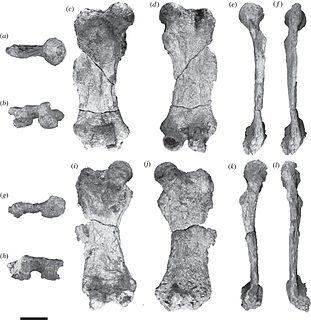
Eionaletherium is an extinct genus of ground sloth from the Late Miocene coasts of Venezuela containing one species: E. tanycnemius.

Oreomylodon is an extinct genus of ground sloth in the family Mylodontidae, endemic to Ecuador during the Pleistocene. The only species, O. wegneri, was long considered to be either a species or subgenus of Glossotherium or a junior synonym of Glossotherium robustum, but studies of its cranial anatomy published in 2019 have supported Oreomylodon as a valid genus, and suggested it is more closely related to Paramylodon. However, a subsequent analysis published in 2020 again sunk Oreomylodon wegneri into Glossotherium, as a distinct species. It shows adaptations to living in a high-altitude habitat, and its fossils have frequently been unearthed in the Interandean Valles of Ecuador, at elevations of between 2,450 and 3,100 meters.
Cullinia is an extinct genus of litoptern, an order of South American native ungulates that included horse-like and camel-like animals such as Macrauchenia. It is only known from fragmentary remains. Cullinia levis is known from Chasicoan remains found in the Arroyo Chasicó Formation of Argentina, and remains from the Brazilian state of Acre and the Huayquerian Ituzaingó Formation have been assigned to Cullinia sp..
Epipeltephilus is an extinct genus of armadillo, belonging to the family Peltephilidae, the "horned armadillos", whose most famous relative was Peltephilus. Epipeltephilus is the last known member of its family, becoming extinct during the Chasicoan period. It was found in the Rio Mayo Formation and the Arroyo Chasicó Formation of Argentina, and in northern Chile.
Rhea mesopotamica is an extinct species of bird in the genus Rhea, whose living species are known as suris, rhea, or choiques. It lived in the Southern Cone of South America.
Pseudoprepotherium is an extinct genus of sloths in the family Mylodontidae. It was widespread across northern South America during the Middle and Upper Miocene around 21 to 5.3 million years ago. Fossil finds are known mostly from Venezuela and Peru. They came out of deposits that had a tropical climate with a water-rich environment. The remains are limited to limb bones, with the exception of a few skulls and teeth. Based on this, a medium-sized to large representative of the mylodonts can be concluded. The genus was scientifically named in 1961. Three species are known today, which were originally assigned to different genera.
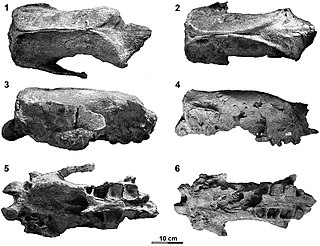
Proeremotherium is an extinct genus of megatheriine ground sloths in the family Megatheriidae. It lived during the Late Miocene and Early Pliocene of what is now Venezuela. So far, two largely complete skulls have been recovered in the Falcón Basin in Venezuela. The finds identify the animals as medium-sized representatives of the Megatheriidae. In the cranial anatomy, Proeremotherium resembles the later and giant Eremotherium. It is therefore assumed that the two ground sloths are directly related to each other.
Archaeomylodon is an extinct genus of mylodontine ground sloths that lived during the Middle Pleistocene of what is now Argentina. It is known so far only from a single skull, which in its dimensions corresponds to those of the giant Lestodon. However, the skull differs from this one by its narrower and higher snout. In addition, the anterior canine teeth, which are usually large in many mylodonts, are greatly reduced. The find comes from the Pampa region of South America and was deposited in about 700,000 years old sediments.
Urumacotherium is an extinct genus of ground sloths of the family Mylodontidae. It lived from the Middle Miocene to the Early Pliocene of what is now Brazil, Peru and Venezuela.
Baraguatherium is an extinct genus of ground sloths of the family Mylodontidae that lived during the Early Miocene of what is now Venezuela. It dates to the Early Miocene, around 20.44 to 15.97 million years ago and represents the oldest representative of its family in the northern part of South America to date. The structure of the teeth suggests that the genus represents a rather basal form within the Mylodontidae. Unlike other mylodonts, which tended to prefer open grasslands, Baraguatherium lived in a riverine, coastal tropical rainforest.
Simomylodon is an extinct genus of ground sloths from the family Mylodontidae. It lived from the Late Miocene to the Middle Pliocene of what is now Bolivia and Argentina, 5.3 to 2.8 million years ago. The most important find material comes from the central Altiplano in Bolivia and includes several skulls and dentition remains. Thus, the so far documented body skeleton is the best known and most significant of a Miocene representative of the Mylodontidae. On the basis of the remains it can be concluded that it is a rather small member of the Mylodontidae. Within the skull material a robust and graceful form can be distinguished, which are probably associated with male and female animals. The in detail partly different skull characteristics allow conclusions on deviating behaviors. The construction of the limbs supports ground-dwelling locomotion, but this does not exclude occasional digging or climbing. The type and only known species is Simomylodon uccasamamensis.

Scirrotherium is an extinct genus of pampatheres, a family of herbivorous cingulates, related to the similar but smaller modern armadillos, and with the now extinct glyptodonts, well-known from their shell-like armor. Its scientific name is derived from the Greek prefix "skiros-", "cover", and the suffix "-therion, "beast", while the name of the type species, hondaensis, honors the town of Honda, in the Tolima Department of Colombia. Scirrotherium is one of several genera of xenarthrans found in the La Venta fauna, dated from the Middle Miocene.
Comaphorus is a dubious extinct genus of glyptodont. It lived during the Late Miocene in Argentina, but only one fossil has ever been referred to the animal.










